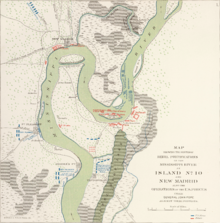CSS New Orleans
 New Orleans, as portrayed by the Union The Philadelphia Inquirer on April 11, 1862[1]
| |
| History | |
|---|---|
| Name | New Orleans |
| Commissioned | October 14, 1861 |
| Fate | Scuttled, April 8, 1862 |
| Notes | Captured by Union forces and used as a floating drydock. Burned by the Confederates in August or September 1863 |
| General characteristics (as designed) | |
| Type | Floating battery |
| Armament |
|
| Armor | Iron sheathing |
CSS New Orleans was a
Construction and characteristics
In early 1861, the secessionist
Both floating batteries were converted from existing
Service history

New Orleans was commissioned on October 14, 1861, commanded by Lieutenant Samuel W. Averett.[12] First Lieutenant John J. Guthrie commanded Red Rover.[11] On November 20, New Orleans was sent up the Mississippi River from New Orleans, towed by CSS Ivy. Red Rover left New Orleans five days later, and later met Ivy at Columbia, Arkansas, where it took over the process of towing New Orleans. The floating battery reached Columbus on December 11.[13] The total crew of the floating battery numbered nine officers and about 25 enlisted men at the time that it left New Orleans.[14] At this time, it was armed with six 8-inch columbiads;[10] this differed from the designed armament of 20 guns.[11] On January 7, 1862, New Orleans prepared for action upon the approach of Union Navy warships, but the Union vessels withdrew after sighting the floating battery.[15] Four days later, Red Rover towed New Orleans to accompany three other Confederate vessels in an operation that became the Battle of Lucas Bend. Red Rover came under Union fire, and returned to Columbus, still towing New Orleans.[16]
The Confederates abandoned Columbus on March 2 after Union victories at the battle of
April 2 saw the floating battery moved to another position where it could fire on Union shore batteries. The Confederate fire was ineffective, and New Orleans was returned to her prior location. The Union Navy responded by bombarding the floating battery with three vessels, resulting in the floating battery suffering significant damage and one gun disabled. Its mooring cable was shot away, and the battery had to be retrieved by the transport Ohio Belle.
See also
References
- ^ a b c Chatelain 2020, p. 70.
- ^ Chatelain 2020, pp. 7–10.
- ^ Daniel & Bock 1996, p. 1.
- ^ Chatelain 2020, p. 39.
- ^ Chatelain 2020, p. 92.
- ^ Hearn 1995, pp. 78–79.
- ^ a b Canney 2015, p. 176.
- ^ Daniel & Bock 1996, p. 13.
- ^ Canney 2015, pp. 176–177.
- ^ a b c Daniel & Bock 1996, p. 14.
- ^ a b c d e Chatelain 2020, p. 71.
- ^ Chatelain 2020, pp. 70–71.
- ^ Chatelain 2020, p. 75.
- ^ Dufour 1994, p. 106.
- ^ Chatelain 2020, pp. 92–93.
- ^ Chatelain 2020, p. 93.
- ^ Chatelain 2020, p. 98.
- ^ Daniel & Bock 1996, p. 30.
- ^ Daniel & Bock 1996, p. 57.
- ^ Daniel & Bock 1996, p. 34.
- ^ Chatelain 2020, p. 109.
- ^ Chatelain 2020, p. 108.
- ^ Daniel & Bock 1996, p. 35.
- ^ Chatelain 2020, p. 110.
- ^ Daniel & Bock 1996, pp. 120–122.
- ^ Chatelain 2020, p. 115.
- ^ Daniel & Bock 1996, p. 126.
- ^ Chatelain 2020, pp. 116–117.
- ^ Daniel & Bock 1996, p. 136.
- ^ Daniel & Bock 1996, p. 138.
- ^ Canney 2015, p. 177.
- ^ Gaines 2008, pp. 100–101.
Sources
- Canney, Donald L. (2015). The Confederate Steam Navy 1861–1865. Atglen, Pennsylvania: ISBN 978-0-7643-4824-2.
- Chatelain, Neil P. (2020). Defending the Arteries of Rebellion: Confederate Naval Operations in the Mississippi River Valley, 1861–1865. El Dorado Hills, California: ISBN 978-1-61121-510-6.
- Daniel, Larry J.; Bock, Lynn N. (1996). Island No. 10: Struggle for the Mississippi Valley. Tuscaloosa, Alabama: ISBN 0-8173-0816-4.
- Dufour, Charles L. (1994) [1960]. The Night the War Was Lost. Lincoln, Nebraska: ISBN 0-8032-6599-9.
- Gaines, W. Craig (2008). Encyclopedia of Civil War Shipwrecks. Baton Rouge, Louisiana: ISBN 978-0-8071-3274-6.
- Hearn, Chester G. (1995). The Capture of New Orleans 1862. Baton Rouge, Louisiana: ISBN 0-8071-1945-8.
